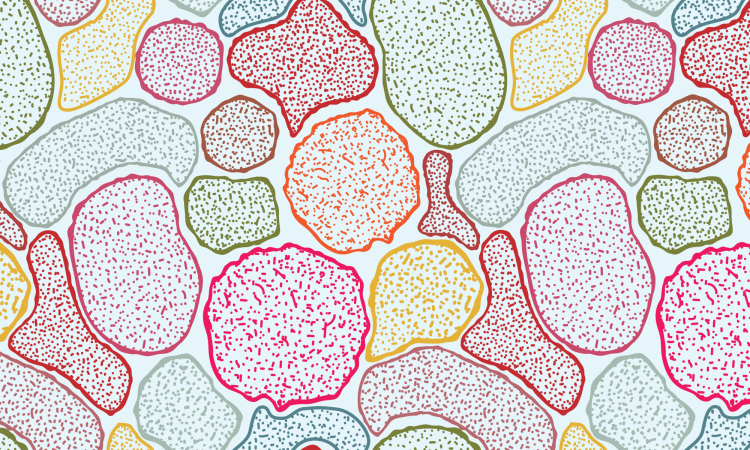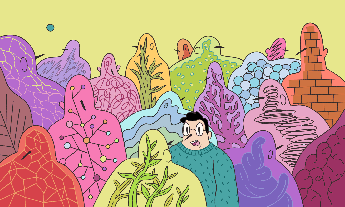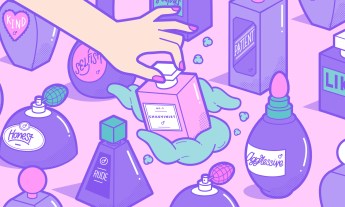
Plus: Why you shouldn’t give probiotics to your dog.
You are never really alone. On your skin, in your nose, in every inch of your personal space, you are accompanied by trillions of tiny organisms. Collectively, these microorganisms are known as the microbiome — the complex ecosystem of microbes that share and shape our world. Yet the quest to understand the microbiome is still in its infancy. What’s the role of the microbiome in human health and wellbeing? How are you affected by the small rainforest of microorganisms that live in every office building, or the collection of microbes in your gut? Science is just beginning to figure that out — and the research will blow your mind.
We invited three scientists to talk about what interested them most about the current microbiome research. Read on for insights from microbiologist Jonathan Eisen (TED Talk: Meet your microbes) evolutionary biologist Rob Knight (read about his 2014 TED Talk), and ecologist and TED Fellow Jessica Green (We’re covered in germs. Let’s design for that).
Research into microbiomes seems to have hit critical mass in the last few years. Why is that?
 Jonathan Eisen: I think there are five or six different related things all happening at the same time. At least some of it is technology — our ability to study microbial communities has gotten better. There has also been pioneering work on human-associated microbial communities. We’ve learned that they play a profound role in various aspects of human health and disease.
Jonathan Eisen: I think there are five or six different related things all happening at the same time. At least some of it is technology — our ability to study microbial communities has gotten better. There has also been pioneering work on human-associated microbial communities. We’ve learned that they play a profound role in various aspects of human health and disease.
the microbial communities in our buildings, in our cars, in our planes, in our hospitals, are all affecting our health.
A third, and maybe fourth, area, are related just to general malaise about the human genome. We spent two billion dollars sequencing the genome — or the government did — and there was this promise that we were going to understand human biology simply from analyzing the genome. But that didn’t work out exactly as we hoped.
And then everybody tried to come up with another way to explain human biology that wasn’t the genome. So there’s been a lot of hype and hope in the epigenome, de novo somatic mutations, and the microbiome. If the genome doesn’t explain everything, a really nice alternative explanation is that on top of the genome, the patterns of microbial communities that people have in and on them may explain a lot of the variation that we see.
 Jessica Green: I might add that with almost any field that you’re in, you can study the microbiome if there are microbes associated with that system. So whether you’re a marine biologist, or you’re interested in agriculture, or you study the atmosphere — all organisms in all environments have microbes associated with them. And there’s a lot to learn in all of those systems.
Jessica Green: I might add that with almost any field that you’re in, you can study the microbiome if there are microbes associated with that system. So whether you’re a marine biologist, or you’re interested in agriculture, or you study the atmosphere — all organisms in all environments have microbes associated with them. And there’s a lot to learn in all of those systems.
 Rob Knight: It’s also important to remember the decrease in cost, which really amps up all these application areas that Jessica was just telling us about. So for example, you might not want to spend $100,000 figuring out what the microbes in your gut look like, but you’d probably pay $100 to do that. Those drops in costs make a lot of these different types of things more feasible.
Rob Knight: It’s also important to remember the decrease in cost, which really amps up all these application areas that Jessica was just telling us about. So for example, you might not want to spend $100,000 figuring out what the microbes in your gut look like, but you’d probably pay $100 to do that. Those drops in costs make a lot of these different types of things more feasible.
All of you study the microbiome, obviously, but you’re focused on different aspects. What’s your favorite microbiome, and why does your research tend to gravitate to that area?
JE: My lab focuses much more on what you could call model organisms, which are not humans, generally. In the past, our favorite system, I probably would say, was drosophila, the fruit fly — in part because it can rear massive numbers of samples, and you can manipulate the host genetically, and you can do all sorts of experimental modifications that can help you learn the principles of how a host interacts with the microbial community.
In the last year or year-and-a-half, we have adopted a new favorite model system in collaboration with Jessica, on the microbiome of seagrasses, which are the marine angiosperms that live fully submerged in the coastal ocean environment. And there are many reasons we’re interested in that — but in general, for me to latch on to a particular system, it’s probably because it helps answer big-picture, fundamental questions about how hosts interact with microbial communities.
Microbes won’t just cure disease in the future — they’re curing disease right now.
JG: The microbiome work that I spend the most time on right now is the built environment. One of the reasons that I am highly motivated to think about the built-environment microbiome is because we spend 90% of our lives indoors. Due to the great amount of time that we spend indoors, there’s a very likely possibility that the built environment is an important source for microbes for the human body. And I’m highly motivated by the possibility that one day we’ll be able to engineer and design buildings and urban spaces in a way that will promote human health and productivity.
We can now match people to their dogs based on the microbes they share.
RK: I love all those microbiomes equally, which is why I focus on trying basic technology platforms.
Rob, you mentioned earlier this year that microbes may help cure disease in the future. How so?
RK: Well, it’s not just that microbes will cure disease in the future, but that they’re doing it right now. At the end of my talk, I discuss fecal microbiota transplants, where you essentially transfer the fecal microbiota from a healthy person to someone with certain disease. For example, there are people with Clostridium difficile infection — the gut microbiome is in a completely ill and dysfunctional state. With the transplant, they come back to the healthy state and stay there. In time, the symptoms can vanish, including diarrhea, which kills 14,000 people a year in the U.S. alone. This is a really important clinical problem.
Being able to demonstrate directly why this microbiome is found to work on behalf of a community trajectory is something I think is really cool and really important. It paves the way for a very large number of other microbiome-based therapies for other diseases.
How might the built microbiome and the human microbiome interact when it comes to our health?
JE: One of the reasons why there’s been a big movement to study the microbiology and microbiomes of the built environment is both the evidence and the hypotheses that the microbial communities that are in our buildings, in our cars, in our planes, in our hospitals, are impacting our health either directly or indirectly.
That’s why my group has gotten involved in this Sloan Foundation program: the Microbiomes of the Built Environment. We’re actually doing communication and outreach related to that. Jessica’s doing experimental studies, and Rob has done a bunch of work, so maybe they can talk more specifically about the actual data on this.
JG: Sure. We know that microbes in the built environment are relevant to human health in the context of pathogens, for example, and how we acquire infections. But I think what we know less about — and it’s very interesting to think about — is the role that microbes have in the built environment in terms of positively affecting health. That’s a direction that I would love to see more research in. And what we’re going to need to do in this realm is understand, based on the human microbiome research, what communities of microbes are beneficial to human health or not.
Could we restore the connection to the environment that we’ve lost through living in hermetically sealed, air-conditioned buildings?
RK: Well, in the human microbiome field, the traditional view of microbes is that we were basically at war with them — you know, we have to put a lot of vigilance standing up to bad microbes with antibiotics, with hygiene practices, and so on. And it was also more or less assumed that everyone had the same microbes in the gut, on the skin, and so forth.
We now know from human studies and from animal studies that the beneficial microbes are playing a tremendous role. For example, what particular collection of beneficial microbes you have in the gut has a large effect on how efficiently you can extract calories from different kinds of food, how likely you are to be able to escape colon cancer or heart disease — even how you metabolize different kinds of drugs.
The beneficial microbes in the guts of mice greatly alter their susceptibility to different kinds of infectious disease. So, having the right microbes to begin with can ward off the harmful pathogens you might come in contact with.
One of the things we need to do is just characterize what’s out there — to look at everything from people living very traditional lifestyles to people living in modern cities, and the interplay between humans and environment. I think there’s tremendous potential for restoring some of the connection to the environment we’ve lost through living in hermetically sealed buildings and relying extensively on air conditioning. Perhaps one solution is to have buildings that a little more open.
That’s so interesting. I did one of the citizen science projects with Your Wild Life, where you swab your home and have the microbes analyzed. I submitted not only samples from my apartment, but also from my dog and from me. I live in Brooklyn, and I was really fascinated that most of the outdoor microbes in my apartment seem to be coming in via my dog, rather than soil or plants, which is the case for more suburban or rural homes. He’s like a vector for outdoorsy bugs.
RK: That really is fascinating. We did a study of household pets and dogs, and we haven’t got around to writing it up in detail. One of the biggest things from the dog microbiome study is that we can match people to their dogs based on the microbes they share.
The microbiome seems to have so much promise. So now I’m going to bring us down a peg, I guess. Or at least bring the press down a peg, because sometimes the findings about the microbiome are a little bit exaggerated or sort of oversold. Jonathan, you write a lot about this on your blog, and even hand out awards for it. So maybe you can start us off: is the microbiome oversold?
JE: I think that in general, scientists — when the findings of their studies are being reported in the press — get very excited about their work. It’s not surprising that scientists will talk about the potential implications of what’s going on, and you see that in every field. What started to get to me was people making a connection between one study — say, that the microbiome was different in people with chronic disease versus healthy people — and then claiming that because of that, therefore their therapy that they were developing related to fermented foods was going to cure Crohn’s disease. It was pure snake oil, but because microbiome work is hot, some of these charlatans have latched on to “microbiome” as the keyword to make ridiculous claims.
It’s important to think about the complexity of what’s going on here. I mean, people have been trying to associate individual human genomes with various “complex diseases” for a while, like heart disease and behavioral issues. They worry about how complicated that is, given the interaction between the human genome and the environment, and all the complexities there.
You are an ecosystem, and it is very complex.
Add in the microbial communities that are in and on people — which in the gut is hundreds to thousands of species — with each of those species having genetic variance, and then those change over time during the course of a lifetime. Then add in diet. Then you’ve got microbes in your mouth, and on your skin, and in your vagina and everywhere else. You are an ecosystem, and it is very complex. Also, we’ve only done a small number of studies right now with limited numbers of people, and with limited time series and limited number of samples.
I think the potential is enormous, but I worry that a lot of people confuse correlation and causation. It seems almost sad to mention this a lot, because people get sick of hearing about this all the time, but there’s no doubt that a lot of the scientists and a lot of the news stories about microbiome studies have confused that.
That doesn’t mean that microbiome isn’t important — I mean, there are hundreds of studies that have shown incredibly important health and disease-related associations and causal effects. This is why I’m working in this area. I just don’t want it to go off the deep end.
Jessica and Rob, do you think the microbiome is being oversold in any way?
JG: I don’t know if the microbiome is being oversold. But what Jonathan said resonates with me, particularly in built environment-themed studies. Because of the complexity of the system, getting at causation is very difficult. One thing I’ve been thinking a lot about recently is using model organisms in model systems where we begin to really focus on built environments using traditional model systems. I don’t know any investigators that are currently using mouse models, for example, and altering the built environment of the mouse model system to understand the interaction between building design and the mouse microbiome, and mouse health, but it’s something that interests me a lot. Rob, do you know of people that are looking at the interface between the built environment and the model so they can determine the microbiome’s health?
RK: Well, that’s a great question, Jessica. I know a lot of people who have written grant applications to study exactly that. But unfortunately while there’s a lot of interest, there’s been a real mismatch between the potential importance of those studies and what you can actually get a research grant for.
Coming back to the original question about whether the microbiome is oversold, it’s certainly true that individual studies can be oversold, especially when the correlation-with-causation issue is downplayed. Part of the problem is that we know a lot of diseases can affect the microbiome — so figuring out whether the microbes either cause the disease or whether they’re a side effect or an effect of the physiological changes is really important.
Another issue is that the public enthusiasm for microbially based therapies greatly exceeds the factual evidence that we have. So for example, I live in Boulder, and the Boulder Whole Foods has aisle after aisle of probiotics. But the number of those bacteria that have actually been validated in any type of randomized control study is essentially none. Illustrating this problem is the wrong idea that a lot of people have that all probiotics are interchangeable, and it doesn’t really matter which probiotic you take, as long as you take a probiotic.
JE: Then there are people making the same claims about human health and the health of cats and dogs. As Rob was saying, Whole Foods actually sells pet food with probiotics. And there are clinics that are promoting fecal transplants to treat schizophrenia. You know, could it work? I don’t know. But certainly there’s no evidence for many of these things. There are just so many areas where people are making these claims.
There’s no doubt that people are going to be doing human biological enhancements via microbes, just like they do via doping and drugs.
RK: It’s really important to remember that there are probiotics that have been clinically validated for specific medical conditions. I won’t give specific examples, but there’s a body of literature that shows some probiotics have real effect. But just because it works in humans, that doesn’t mean you should give it to your dog or cat — keep in mind the effect of chocolate on dogs, for example, and the physiological differences between species. You would want to be as careful about doing that with microbes as you are with drugs.
I know we were talking about overselling the microbiome, but now I’m going to ask you to think in the opposite direction and predict what you think could be the craziest, most science-fiction-sounding future microbiome product or trend that just might work.
JE: I think there’s no doubt people are going to be doing human biological enhancements via microbes, just like they do via doping, and drugs. It’s going to happen in more and more ways, for better or worse, via microbes.
JG: I’m actually working on a science fiction graphic novel right now. The title of it is Noli Timere — which is the Latin for “do not be afraid.” The first chapter opens up in Paris, where there’s a viral assault that comes in from another continent and lands on trees, the most common trees in Paris. It colonizes this tree, and then it wafts into the first apartment floor and colonizes that room, and then it spreads among all the people that live in the building. It’s a beneficial microbe, a bacterium, that enables people to be able to understand one another in ways that they were unable to before.
So I can imagine a future where — and this is way off in the future — where there are particular carriers of supernatural bacteria that are extremely beneficial, and people are trying to think about ways to spread those microbes among people in their communities, and pharmaceutical companies are also trying to make what they can out of that situation.
RK: Well, the microbes in your gut weigh about as much as your brain, and if you think about the number of components in there and the number of connections between those components, in terms of exchange of molecules, genes, and so forth, you really do have a system that rivals the complexity of our brains. So if the connectivist account of artificial intelligence turns out to be correct, the level of complexity implies that we should be able to design a microbiome that can think. That’s a fascinating idea.












